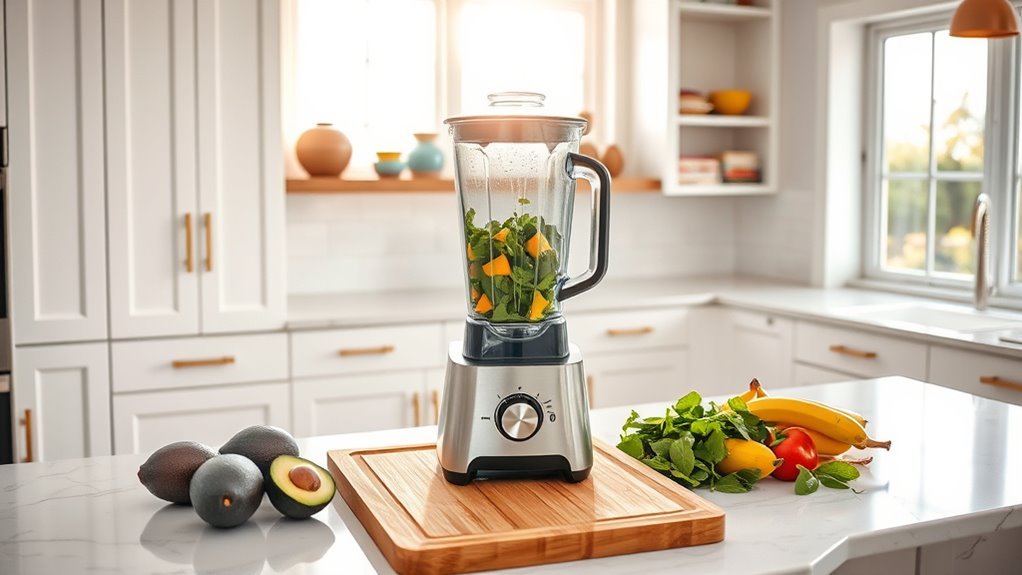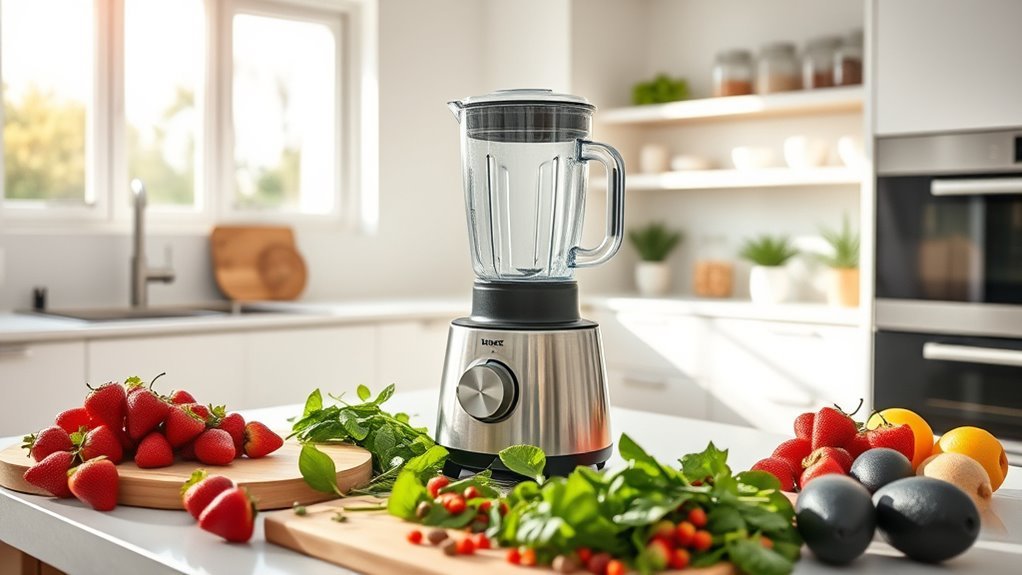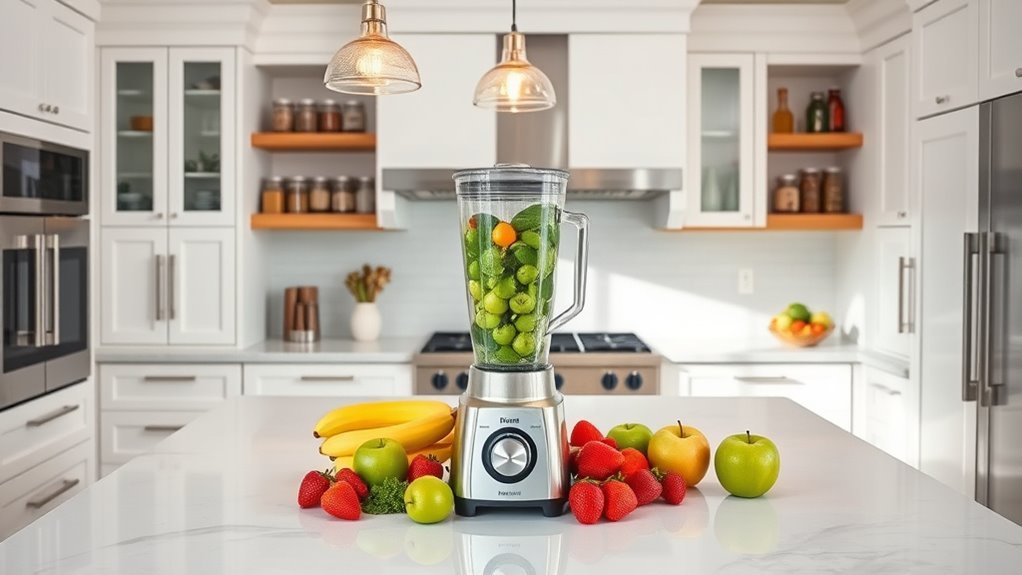We’ll tell you straight – variable speed dials are the secret weapon for perfect blending. Modern countertop blenders pack 5-11 distinct speeds, with Intelli-Speed tech that automatically adjusts to ingredients. Start low for delicate items like herbs, crank it up for tough stuff like ice and nuts, and use pulse for precise texture control. Regular maintenance keeps your dial system performing effectively. There’s more to mastering these game-changing controls than meets the eye.
Understanding Variable Speed Technology in Modern Blenders

When it comes to modern blending technology, variable speed control isn’t just a fancy feature – it’s the beating heart of precision food preparation.
We’re talking about sophisticated variable speed technology that puts texture control right at our fingertips, with 5-11 distinct speeds for ideal customization.
The magic happens through innovations like Intelli-Speed Motor Control, which actively senses what’s in your blender and adjusts for consistent results.
Whether we’re crafting silky smoothies and soups or tackling chunky salsas, these high-performance machines deliver.
The variable speed dial works seamlessly with preset recipe programs, revolutionizing our blending techniques.
From gentle stirring to aggressive liquefying, we’re now equipped with professional-grade control that transforms every kitchen into a culinary command center. Additionally, high-performance blenders can handle tough ingredients effortlessly, making them indispensable for any serious cook.
The Benefits of Precision Control in Blending
Precision stands as the cornerstone of successful blending, and variable speed control puts that power directly in our hands. We’re not just mixing ingredients – we’re crafting textures with surgical accuracy.
With 5-speed settings, we can transform chunky vegetables into silky smooth purees at the turn of a dial.
Let’s talk game-changers: Intelli-Speed Motor Control automatically adjusts to ideal speed based on what we’re blending. No more guesswork.
When we combine this with pre-programmed recipe settings, we’re looking at foolproof consistency every time.
Add a tamper to the equation, and we’re pushing ingredients right where they need to go, ensuring every particle gets its fair share of blade action.
That’s the difference between amateur hour and professional-grade results in your kitchen. High-performance blenders, with their variable speed settings, elevate your blending experience by providing unmatched versatility and control.
Essential Speed Settings for Different Ingredients

Mastering your blender’s speed settings isn’t just about pushing buttons – it’s about understanding the unique demands of each ingredient.
We’ll help you nail the perfect blending technique for any recipe.
Let’s start with nut butters – they need a gentle touch. Begin on low speed, then ease into medium for that creamy texture.
For smoothies, crank it to high speed setting to demolish ice and fiber. Got tough ingredients like kale or frozen fruit? Work your way from low to high for thorough blending.
The Pulse setting is your precision tool for chunky textures – perfect for fresh salsa.
With variable speed controls like those on the KitchenAid K400‘s 5-setting dial, we’re matching texture requirements to specific ingredients.
It’s all about control, timing, and knowing when to push your blender’s limits.
Mastering Texture Control With Speed Adjustments
How well you control texture comes down to mastering those variable speed dials. With the KitchenAid K400’s five distinct speeds, we’re talking precise texture control from silky smooth to intentionally chunky.
Let’s put that Intelli-Speed Motor Control to work. Start with the Soft Start feature to prevent splatter, then ramp up the blending speed as needed. Tough ingredients like leafy greens? No problem. The motor automatically adjusts for ideal blending performance.
For specific tasks, we’ve got specialized settings like Smoothie that take the guesswork out. It’s about matching the right speed to your ingredients – low for gentle folding, high for complete pulverization.
With variable speeds at your fingertips, you’ll nail the perfect consistency every time, whether you’re crushing ice or whipping up perfectly textured dips.
Low-Speed Applications for Delicate Blending

When it comes to delicate ingredients, low-speed blending is your secret weapon. We love how low-speed settings preserve ingredient integrity while ensuring thorough mixing – perfect for those chunky mixtures where texture matters most.
The KitchenAid K400’s soft start function shows why precise blending control is significant. Its variable speed dials lets gradually ramp up from gentle mixing to more intense blending, preventing that dreaded over-processing of delicate ingredients.
We’re talking perfect salsas or dips every time, where you want recognizable chunks, not soup.
Think of low speeds as your insurance policy against pulverized produce. Whether you’re working with tender herbs or soft fruits, these settings give you the control to blend just enough while maintaining that vital blending texture you’re after.
High-Speed Performance for Tough Ingredients
Though delicate ingredients demand a gentle touch, tough materials require the raw muscle of high-speed power.
We’ve found that variable speed settings are essential when you’re tackling stubborn ingredients like kale and frozen fruits. The powerful blender’s Intelli-Speed Motor Control automatically detects what’s in your container and maintains ideal speed for consistent texture.
Let’s talk about why this matters: A unique asymmetric blade design, cutting at four distinct angles, creates a powerful vortex that demolishes tough ingredients.
With 1.5 Peak HP at your disposal, you’ll blast through almonds and ice like they’re butter.
And here’s the clever part – the soft start feature prevents that annoying initial splatter by ramping up gradually. It’s high-speed performance with a brain, delivering precisely the texture you want.
Speed Dial Features That Enhance Recipe Results
Since precision control makes or breaks your recipes, let’s plunge into the game-changing speed dial features that’ll revolutionize your blending.
Modern blenders pack intelligent features like variable speed settings and Intelli-Speed Motor Control, automatically adjusting to ingredient toughness. The dynamic combo of preset recipe programs, asymmetric blades, and ribbed jar design creates an unstoppable blending vortex.
- Watch tough ingredients surrender to Ice Crush mode as the 5-speed dial pulverizes frozen chunks
- Experience the perfect smoothie texture as preset programs cycle through ideal speeds
- Feel the confidence as soft start prevents ingredient splatter and mess
- Witness the vortex action pull everything into the blade’s path for complete texture control
This isn’t just blending – it’s precision engineering at your fingertips.
Professional Techniques for Speed Dial Operation
As you master professional techniques, the variable speed dial becomes your secret weapon for perfect textures.
We’ll show you how to leverage precise control for everything from smooth purees to chunky salsas.
Let’s start with the fundamentals. For thick mixtures like batters, begin at low speed, then gradually increase to medium – it’s that simple.
When you’re after ideal texture, especially with fibrous ingredients, start slow and methodically ramp up your blending system’s speed settings.
For chopping, we’ll use manual control to nail those perfect dices.
Here’s the pro secret: Let the Intelli-Speed Motor Control do the heavy lifting.
It automatically adjusts to your ingredients’ toughness, so you’ll get consistent results every time.
No more guessing – just pure blending precision.
Optimizing Variable Speeds for Specific Recipes
Now that you’ve mastered the basics of speed control, let’s put that knowledge to work with specific recipes.
Our variable speed blending system delivers superior results when we match speed to purpose. For chunky salsas, we’ll use the pulse feature. For velvety smoothies, we’ll leverage the Intelli-Speed Motor Control at high settings.
- Start at low speed when breaking down tough ingredients like kale or nuts – watching them transform from whole to minced.
- Gradually increase to medium speed for pureeing softer ingredients into silky smoothness.
- Hit high speed for perfect smoothies, pulverizing ice and fibrous ingredients into uniform consistency.
- Use quick pulse bursts for precise texture control, maintaining those desirable chunks in dips and sauces.
Speed Dial Maintenance and Longevity Tips
While your variable speed dial might seem like a simple component, its proper maintenance directly impacts your blender’s performance and lifespan.
Let’s explore essential speed dial maintenance and longevity tips to keep your blender running smoothly.
We’ll start with the basics: clean around the dial regularly to prevent food particles from compromising functionality.
Don’t use excessive force when adjusting speeds – it’s not an arm workout.
Always unplug before cleaning to avoid electrical hazards.
Store your blender in a dry place; moisture is the speed dial’s nemesis.
If your dial becomes unresponsive, check your manual for troubleshooting steps before calling in the pros.
Trust us – these simple practices will extend your blender’s life and keep those smoothies flowing perfectly.
Frequently Asked Questions
How Many Speeds Should a Blender Have?
We recommend 3-5 speeds for basic blending, though having up to 11 speeds offers better texture control and recipe adaptations. More speed variations help optimize blender performance for different ingredient types.
What Is the Best Blender Setting for Smoothies?
We’ll get the best smoothie consistency by starting low for soft ingredients, then increasing to high speed, adjusting based on ingredient combinations and fiber content while monitoring texture for perfect results.
Is the Kitchenaid K400 Better Than the Vitamix?
While the K400 offers good performance at a lower price, we’d recommend Vitamix for superior motor power, durability, and blending consistency, backed by better user reviews and a stronger brand reputation.
What Speed Is Puree on a Blender?
Like mastering a symphony, we’ll find puree speed typically sits at medium-high on most blenders, letting us achieve smooth consistency through gradual speed adjustment from low to ideal settings.

